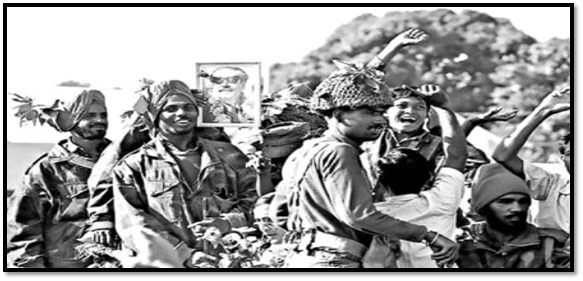| Date: 21-Nov-2025 |
India’s role in Bangladesh Liberation War 1971 was decisive, as the Indian Army and the Mukti Bahini jointly executed coordinated operations that dismantled Pakistani control.. The Mukti Bahini, composed of local freedom fighters, carried out guerrilla, sabotage and conventional operations across multiple fronts. India’s support was vital- they provided training, weapons and safe bases for the Mukti Bahini in Indian territory. Indian forces launched coordinated military campaigns alongside the Mukti Bahini, weakening Pakistani defences and enabling rapid advances. This collaboration not only led to the decisive surrender of the Pakistan Army on December 16, 1971, but also laid the foundation for the newly formed Bangladesh Armed Forces. Indian assistance in training and organizing combat units helped transform the liberation fighters into a structured national army, crucial for Bangladesh’s early security and sovereignty.

Unified Command and Coordination
In the months leading up to the formal Indian military intervention, the Mukti Bahini grew in organization and strength, transforming from loosely coordinated guerrilla bands into a more structured force. By late 1971, the Mukti Bahini was estimated to have about 30,000 trained regular fighters organized in brigades along with an additional 100,000 guerrilla fighters conducting asymmetric warfare. To harness this potential, a joint command known as the Mitro Bahini (Allied Forces) was established on November 21, 1971. Under this unified command, led by Indian Lieutenant General Jagjit Singh Aurora, Mukti Bahini brigades were integrated into coordinated military operations with the Indian Army’s three corps deployed on the eastern front. This integration enabled effective sharing of intelligence, operational planning and real-time battlefield coordination.
Tactical and Strategic Operations
The Mukti Bahini’s guerrilla activities involved targeting Pakistani communication networks, supply lines and isolated military posts to erode enemy strength and disrupt their control. Indian forces augmented this by launching large-scale conventional operations, opening multiple fronts and applying sustained pressure on Pakistani units. The complementary nature of these tactics meant that the Pakistan Army was stretched thin, facing both unconventional warfare from within and a concerted conventional military offensive. Close-quarter battles, such as those near Gazipur, demonstrated the seamless cooperation between Mukti Bahini fighters, familiar with local terrain, and Indian troops equipped for large-scale combat.
Decisive Victory and Military Legacy
The war culminated with the Pakistani surrender on December 16, 1971, a moment of profound significance marking the triumph of the Mitro Bahini alliance. Major General Jamshed of the Pakistani Army capitulated to the combined forces in Dhaka, formally ending the conflict and laying the groundwork for Bangladesh’s independence. Crucially, the collaboration between the Mukti Bahini and Indian Army did not end with the war; the experience gained by Mukti Bahini fighters, coupled with continued Indian assistance in training and organizational support, was foundational in establishing the Bangladesh Armed Forces. Veterans of the liberation struggle became core to Bangladesh’s new military structure, ensuring the nascent state’s early security and sovereignty.
Building a Unified Foundation
The collaboration between the Mukti Bahini and the Indian Army extended beyond battlefield coordination to the very formation of Bangladesh’s security institutions. As liberation progressed, the experience and organizational discipline gained by Mukti Bahini fighters- complemented by Indian training, logistics and strategic guidance- were pivotal in transforming irregular volunteers into a structured military force. Post-war, many of these trained veterans were integrated into the nascent Bangladesh Armed Forces, while Indian mentorship continued to shape doctrine, leadership, and professional standards. This enduring synergy not only secured independence but also laid the essential groundwork for Bangladesh’s early national defence architecture.
Conclusion:
The 1971 Bangladesh Liberation War exemplifies how strategic coalition warfare, combining indigenous guerrilla efforts with conventional interstate military power, can overturn entrenched regimes. The Mukti Bahini and Indian Army’s integrated operations broke Pakistani control in East Pakistan, culminating in the largest military surrender since World War II. Beyond victory, the collaboration’s legacy endures in the Bangladesh Armed Forces’ foundation and enduring India-Bangladesh military ties, crucial for regional stability. This synergy underscores the potency and complexity of liberation struggles supported by external allies, blending military, political and humanitarian dimensions in the quest for national independence.
References:
https://organiser.org/2021/12/13/15854/bharat/mukti-bahini-a-saga-of-courage/ https://en.wikipedia.org/wiki/Mitro_Bahini_order_of_battle
https://en.banglapedia.org/index.php/Mukti_Bahini
